Owning a turtle that stays small has many benefits, but even though they come in a smaller package doesn’t necessarily mean they’re easier to care for.
In this guide, you’ll learn:
- Which turtles stay small even into adulthood?
- Do smaller turtles make good pets?
- How do I care for a small turtle?
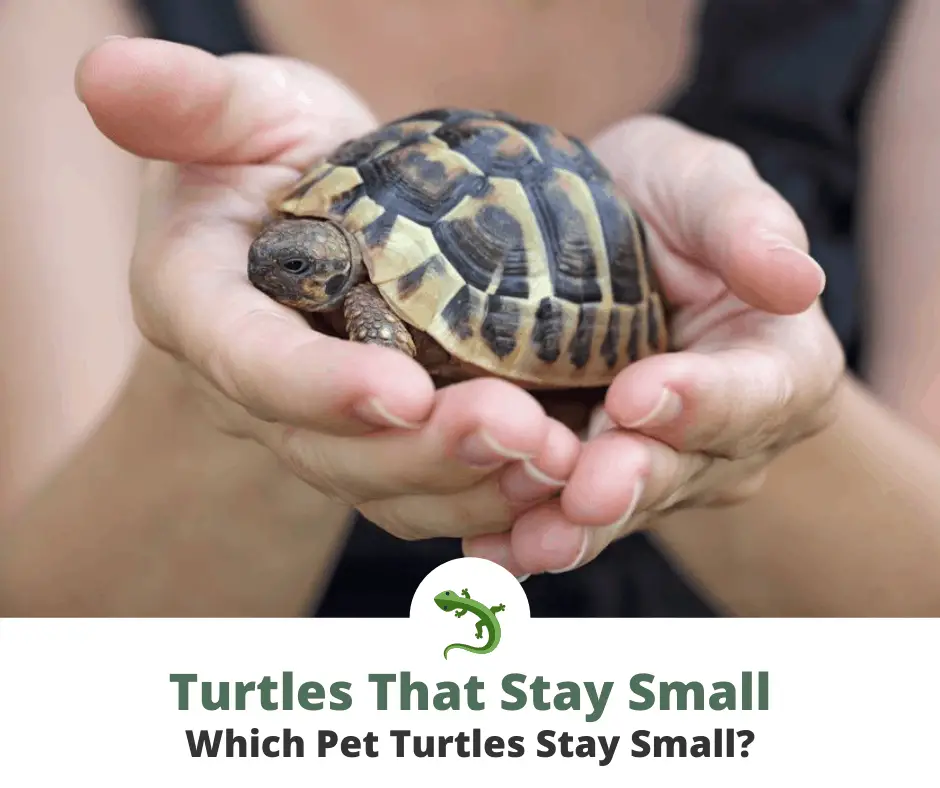
Small pet turtles are a popular choice for many reasons, but some people may need to learn that an entire range of turtles stays small. If you’re looking for a turtle to keep as a pet and don’t want one too large in size, then the Red-Eared Slider Turtle, Musk Turtle, Painted Turtle, Box Turtle, and Caspian Pond Turtles might be your best options. Each type has its unique appearance and needs regarding habitat requirements, diet and feeding habits, and health considerations.
Important
Although these turtles stay small, they require large enclosures and sometimes live up to 50 years. Please own one responsibly.
Turtles That Stay Small And Make Great Pets
- Common Musk Turtle (4-5 inches)
- Box Turtle (5-7 inches)
- Painted Turtle (4-6 inches)
- Caspian Turtle (8 inches)
- Red-Eared Sliders (8-10 inches)
Common Musk Turtle
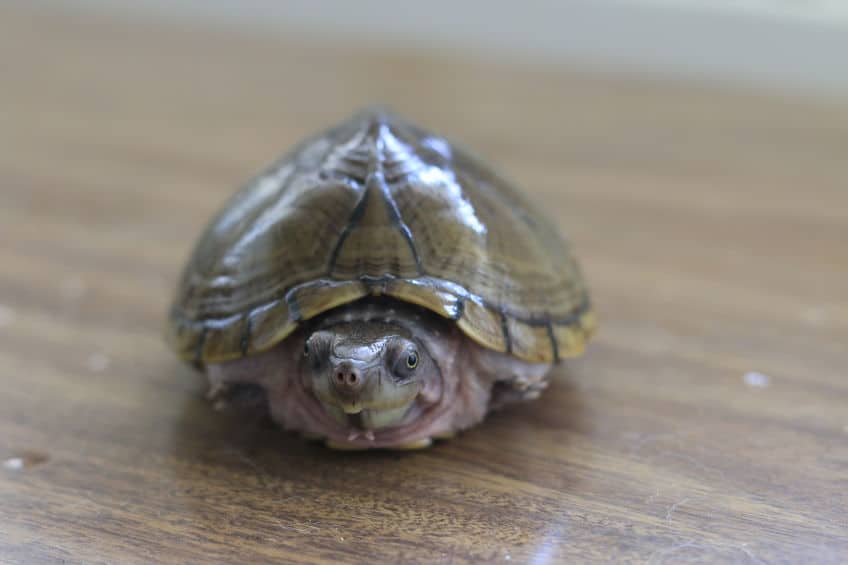
How Big Do Musk Turtles Get?
The musk turtle is a small turtle growing up to 4-6 inches in length. They have a dark brown or black carapace with yellow stripes running along the sides and back. Their plastron (bottom shell) is usually light-colored with darker spots scattered throughout. Musk turtles are native to North America, and typically found in slow moving rivers or streams with plenty of vegetation for hiding spots.
Diet Requirements
Their diet consists of aquatic plants, insects, worms, fish, shrimp, and commercial turtle food pellets designed explicitly for turtles like musk turtles which contain all the necessary vitamins and minerals needed for growth and health maintenance.
Habitat & Enclosure
To keep your musk turtle healthy, they require a 60-gallon tank with UVB lighting access and a basking area for warmth. The water should be kept at around 75°F, and the basking spot should reach 85°F during the daytime hours.
A good filtration system will help prevent a cloudy turtle tank and maintain clean water conditions. We recommend regular water changes every 1-2 weeks, depending on how heavily stocked your tank is. Additionally, adding live plants can provide extra cover for them to hide under when feeling stressed or scared from sudden movements or loud noises outside their enclosure.
Health Problems
Common illnesses include respiratory infections caused by stress or unclean living conditions; therefore it is essential to keep an eye out for any signs of distress like lethargy, loss of appetite, or labored breathing so that action can be taken immediately if needed.
📚 Read More >> Best Turtle Tanks
Do They Musk Turtles Good Pets?
Yes, common musk turtles make great pets. They can be more feisty than others and their larger jaws encourage snapping, so they may not enjoy being held (like most turtles).
Box Turtles
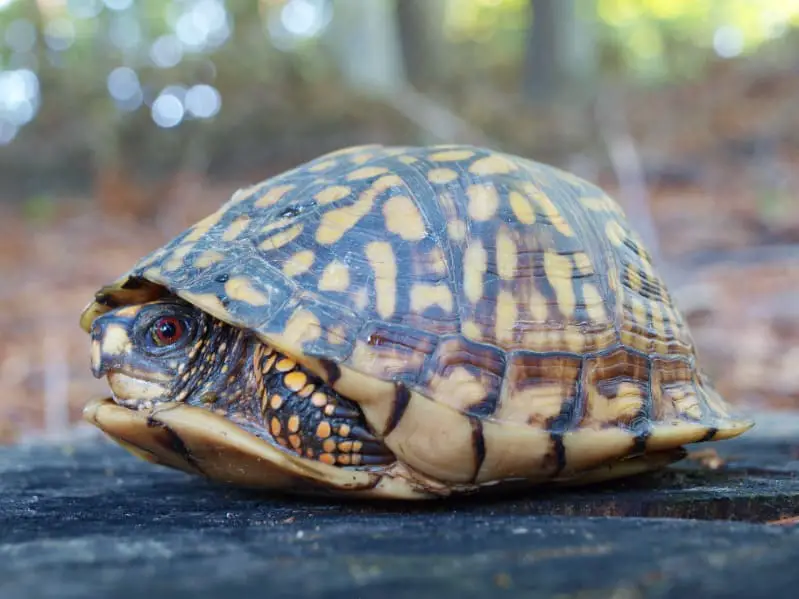
How Big Do Box Turtles Get?
Box turtles typically reach 5-7 inches in length and can live up to 50 years if properly cared for. Box Turtles are a popular pet turtle species due to their small size and docile nature. They have an attractive, dark-colored shell with yellow or orange markings that make them stand out in any tank.
Box turtles have a unique dome-shaped carapace (upper shell) that is usually black or brown with yellow or orange spots on the scutes (the individual plates of the upper shell). The plastron (lower shell) is hinged so it can close completely when threatened, giving box turtles their name. Their head, neck, legs, and tail are also patterned with yellow or orange spots.
Diet Requirements
In captivity, box turtles require a varied diet consisting mainly of leafy greens such as kale and collard greens, along with other vegetables, like squash and carrots, every few days. Turtle pellets are a staple food item to mix in and provide diversity in diet. Mazuri, Reptomin, and Zoomed are good brands to look for.
Important
Fruits like apples and bananas should only be given occasionally due to their high sugar content, which could lead to health issues.
Protein sources include worms, crickets, mealworms etc., but live prey items must always be dusted with calcium powder before feeding; this helps ensure proper bone development within growing baby/juvenile boxies.
Habitat & Enclosure
Box turtles need plenty of space to roam around in their enclosure since they’re active during the day and at night. A 50-gallon aquarium filled with a substrate such as coconut fiber works excellent for housing one adult box turtle; two adults should be kept in an 100-gallon tank instead. Place several hiding places, such as logs, rocks, plants, etc., throughout the enclosure, so your turtle has somewhere to retreat when feeling stressed out or scared by its environment.
Provide full spectrum lighting over part of the habitat so your turtle can bask under it during daytime hours; this will help keep him warm enough while he’s awake and alert him that it’s time to start looking for food! UVB light bulbs should also be used since these provide essential vitamins needed for healthy growth & development in reptiles like box turtles. Lastly, add a shallow water dish large enough for your turtle to submerge itself fully if desired; this will also serve as a drinking source!
Do Box Turtles Make Good Pets?
Yes, box turtles make great pets. Like all turtles they can be messy eaters, so keep that in mind!
Painted Turtle
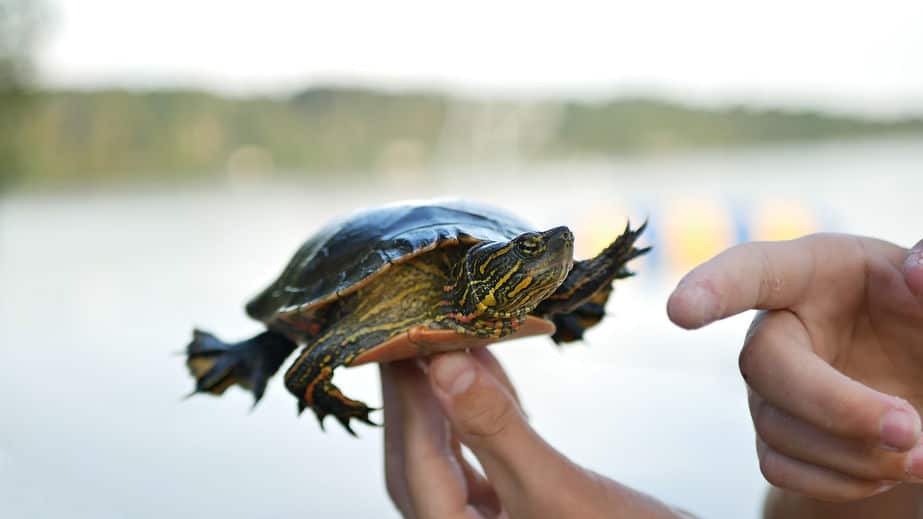
How Big Do Painted Turtles Get?
The painted turtle is one of the most popular pet turtles that stay small, growing up to 4-6 inches in length on average. They are native to North America and can be found in ponds, lakes, rivers, and streams with plenty of vegetation for hiding spots.
Painted turtles have a smooth dark green or black shell with yellow stripes running along the edges. Their underside is usually yellow or orange with red markings near their neck. They also have webbed feet, which help them swim quickly through the water.
Diet Requirements
Painted turtles are omnivores, so they need both plant-based foods like aquatic plants, lettuce, kale, etc., as well as protein sources such as insects, worms, fish, shrimp, snails, crayfish, etc. It would help if you fed them twice daily but ensure not to overfeed them since this could lead to health problems.
Additionally, you can supplement their diet by providing commercial turtle food if desired.
Habitat & Enclosure
To keep your painted turtle healthy, it’s essential to provide them with an adequate habitat that meets all its needs. This includes a large tank filled with clean filtered water, access to UVB lighting, and a basking area where they can warm up when needed. A 60-80 gallon tank is recommended to house one painted turtle.
It should also include plenty of plants and rocks for hiding spots so they feel safe while swimming around in their environment.
Do Painted Turtles Make Good Pets?
Painted Turtles are a great choice for reptile owners looking for a small turtle that is easy to care for.
Caspian Turtle
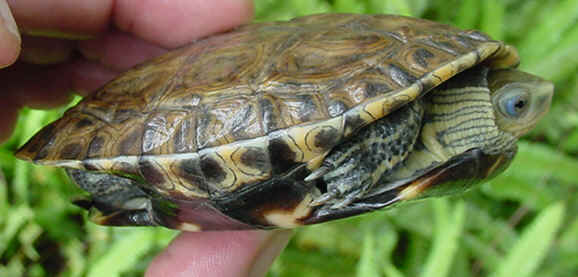
How Big Do Caspian Turtles Get?
The Caspian Pond Turtle is a small, freshwater turtle native to Central Asia. It has an oval-shaped shell that can reach up to 8 inches in length and weigh up to 2 pounds. Its carapace (upper shell) is dark brown or black with yellow spots, while its plastron (lower shell) is yellowish-brown with darker markings. The head and limbs are olive green with yellow stripes.
Diet Requirements
In the wild, these turtles feed mainly on aquatic plants such as duckweed but will also consume insects like dragonfly larvae when available, along with other invertebrates found in the water column such as snails or crayfish.
Captive specimens should be fed a diet rich in calcium, vitamins A & D3, phosphorus, magnesium, iron, zinc, copper & selenium. Commercial pellets designed explicitly for turtles should make up about 75% of their diet, supplemented by fresh fruits/vegetables twice weekly.
Habitat & Enclosure
This species of turtle prefers shallow bodies of water such as ponds, lakes, streams, rivers, marshes, and swamps where they can find plenty of aquatic vegetation for food as well as basking sites on logs or rocks close by the shoreline.
An 80-gallon tank is ideal for caspian turtles and UVB lighting must be provided for 12 hours daily help them to properly synthesize vitamin D3. This helps regulate calcium metabolism and is essential for proper bone growth and development.
Keep clean water within easy reach of the animal and provide ample space inside and outside their enclosure, so they have room to swim freely without feeling cramped or stressed out; this could lead to serious health issues down the road if not addressed promptly.
Do Caspian Turtles Make Good Pets?
Yes, Caspian turtles make good pets and can live up to 50 years in captivity.
Red-Eared Sliders
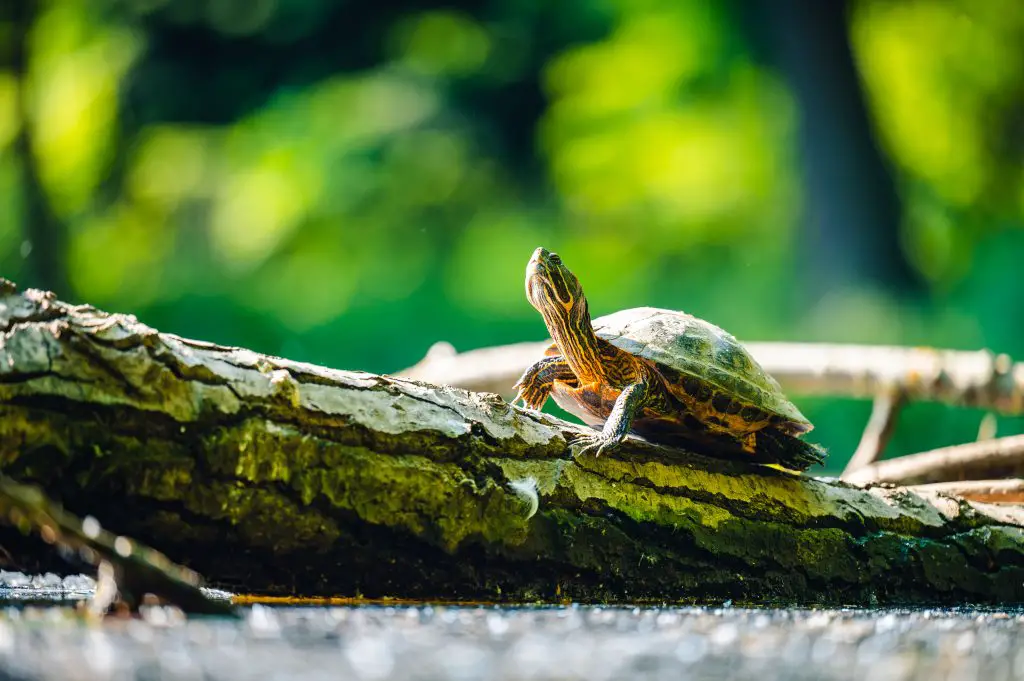
The Red-Eared Slider Turtle is a popular pet for reptile owners due to its small size and hardy nature.
How Big Do Red-Eared Sliders Get?
The Red-Eared Slider Turtle is a popular pet that stays small, growing to an average of 8-10 inches in length. Females get larger and can reach up to 12 inches. They are native to the south-central U.S. from Texas to West Virginia and can be found in ponds, lakes, and slow-moving streams.
The red-eared slider turtle has a green or brown shell with yellow stripes on its head and neck. It also has a distinctive red patch behind each eye, giving it its name. In addition, they have webbed feet for swimming and long claws used for digging.
Pro-Tip ⚡
You need 10 gallons of tank for every inch of shell. If your turtle is 6 inches, it needs at least a 60 gallon tank.
Diet Requirements
Red-eared sliders are omnivores, so their diet consists of aquatic plants, insects, worms, commercial turtle food pellets, shrimp pellets, or crickets supplemented by occasional treats like boiled chicken or fish fillets cut into small pieces. Feed your turtle twice daily but only give it what it can eat within five minutes so that there is no uneaten food left in the tank, which could lead to bacterial growth.
📚 Read More >> Best Plants For Turtles
Habitat & Enclosure
These turtles require a large tank with access to UVB lighting and basking areas where they can warm up during the day. At least a 100-gallon tank should be used with RES, since they grow to become the largest in our list of turtles that stay small. The water should be kept at around 75 degrees Fahrenheit (24 Celsius) with plenty of hiding places, such as rocks or logs, for them to explore.
To ensure the habitat remains clean, 25% of the water should be changed out each week using dechlorinated tap water before adding any supplements back into the tank after it has been thoroughly cleaned with hot soapy water and all surfaces have been rinsed off entirely before refilling.
Health Problems
It is crucial to monitor your turtle’s health regularly, as they are prone to respiratory infections due to poor water quality caused by overfeeding or not cleaning their tanks often enough. This could also lead to shell rot if not treated quickly with antibiotics prescribed by a veterinarian.
Do Red-Eared Sliders Make Good Pets?
Yes, red-eared sliders make good pets. However, they do require more maintenance than people expect.
What Are The Main Benefits Of Owning Small Turtles?
FAQs
Are there turtles that stay small forever?
Yes, there are turtles that stay small forever. These include species such as the African Side-necked Turtle, the Red-eared Slider, and the Spotted Turtle. All of these species have a maximum shell size of fewer than 8 inches in length when fully grown. While they may develop slowly over time, they will never reach sizes much larger than this. Therefore, it is important to research each turtle species before purchasing to ensure it is suited for your environment and lifestyle.
What is the smallest turtle to keep?
The smallest turtle to keep as a pet is the Spotted Turtle (Clemmys guttata). This species typically reaches 4-6 inches in length and can live up to 40 years. They are omnivorous, meaning they eat both plant and animal matter. They require clean water, UVB lighting, and temperatures between 70-80°F during the day, with a slight drop at night. These turtles are semi-aquatic, so they need access to land and water areas for swimming. Proper care should be taken when handling them due to their delicate shells. With the right environment and care, Spotted Turtles can make excellent pets.
What is the smallest fully grown turtle?
The smallest fully-grown turtle is the Speckled Padloper Tortoise (Chersobius signatus). It typically grows to a maximum length of 4.3 inches and weighs up to 3 ounces. This species is native to South Africa and inhabits rocky, semi-arid regions where it feeds on grasses, succulents, and other vegetation. They are illegal to own and often die in captivity.


